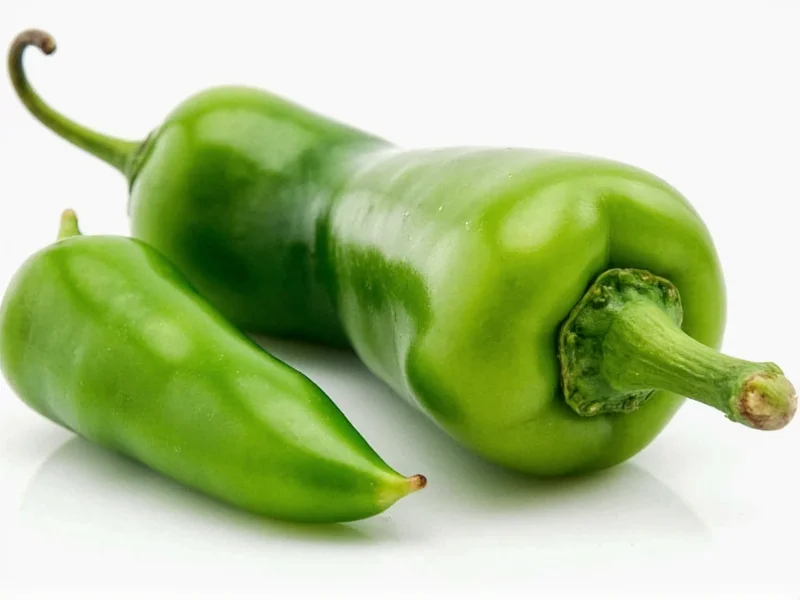When selecting between chile serrano and chile jalapeno for your recipes, understanding their distinct characteristics is essential for achieving the desired flavor profile and heat level. These two popular Mexican peppers often cause confusion in the kitchen, but their differences significantly impact cooking results.
Heat Level Comparison: The Critical Difference
The most significant distinction between serrano vs jalapeno peppers lies in their heat intensity. Serranos consistently rank hotter on the Scoville scale, delivering 10,000-23,000 SHU—nearly three times the maximum heat of jalapeños, which range from 2,500-8,000 SHU. This substantial difference means substituting one for the other without adjustment can dramatically alter a dish's spiciness.
When handling serrano peppers, exercise extra caution as their higher capsaicin content can cause more intense skin and eye irritation. Always wear gloves when preparing large quantities of serranos, especially if you have sensitive skin.
| Characteristic | Serrano Pepper | Jalapeño Pepper |
|---|---|---|
| Scoville Heat Units | 10,000-23,000 SHU | 2,500-8,000 SHU |
| Average Length | 1-3 inches | 2-4 inches |
| Shape | Straight, smooth | Curved, often wrinkled |
| Wall Thickness | Thin | Thick |
| Flavor Profile | Bright, grassy, herbal | Vegetal, slightly sweet, earthy |
| Common Colors | Green, red, orange | Green, red |
| Best Culinary Uses | Salsas, hot sauces, garnishes | Stuffing, pickling, roasting |
Physical Characteristics and Identification
Visually distinguishing chile serrano vs chile jalapeno is straightforward once you know what to look for. Serranos are smaller (typically 1-3 inches long) with a straighter, smoother appearance and thinner walls. They grow upright on the plant, which contributes to their firmer texture. Jalapeños are larger (2-4 inches), often slightly curved with characteristic wrinkles, and have noticeably thicker walls that make them ideal for stuffing.
Both peppers start green and mature to red, though serranos also frequently appear in orange varieties. The skin of serranos remains relatively smooth throughout ripening, while jalapeños develop more pronounced striations as they age and are exposed to sunlight.
Flavor Profiles and Culinary Applications
Understanding serrano pepper vs jalapeno flavor differences is crucial for recipe development. Serranos deliver a cleaner, brighter heat with distinct grassy, herbal notes that work exceptionally well in fresh salsas and pico de gallo where their sharp heat can shine. Their thinner walls mean they cook faster and integrate more completely into sauces.
Jalapeños offer a more complex flavor profile with earthy, slightly sweet undertones that become more pronounced when roasted. Their thicker flesh holds up better to cooking methods like grilling, stuffing, and pickling. The popular preparation method of rajas (sliced, roasted jalapeños) showcases their ability to develop rich, smoky flavors that serranos cannot replicate due to their thinner walls.
Substitution Guidelines and Practical Usage
When substituting serrano for jalapeno or vice versa, precise adjustments are necessary due to the significant heat difference. For serrano vs jalapeno substitution in recipes:
- To replace jalapeños with serranos: Use half the amount of serranos to achieve similar heat levels
- To replace serranos with jalapeños: Double the amount of jalapeños, though full heat equivalence may not be achievable
- Always remove seeds and membranes from serranos for milder applications
- Consider using jalapeño powder when a serrano's fresh flavor is needed but with less heat
Professional chefs often combine both peppers in complex sauces—using jalapeños for base flavor and body, then adding serranos for heat intensity. This technique allows control over both flavor dimensions and spiciness without compromising the dish's integrity.
Availability and Seasonal Considerations
In most North American grocery stores, jalapeños enjoy wider availability year-round due to their popularity in mainstream cuisine. Serranos, while increasingly common, may be seasonal or limited to specialty markets, particularly outside summer and early fall when they're harvested.
When fresh serranos are unavailable, consider these alternatives for serrano vs jalapeno recipes:
- Fresh: Use half the amount of Thai bird chilies with caution (much hotter)
- Dried: Guajillo peppers provide similar fruitiness with less heat
- Powder: A combination of cayenne and paprika can approximate the flavor profile
Storage and Preservation Techniques
Both peppers respond well to similar preservation methods, but their structural differences affect results. Jalapeños' thicker walls make them superior candidates for pickling and canning, maintaining better texture through the process. Serranos work exceptionally well for drying and powdering due to their thinner flesh and higher heat concentration.
For optimal freshness:
- Refrigerate unwashed peppers in perforated plastic bags for 2-3 weeks
- Freeze whole peppers for up to 6 months (thaw before using in cooked dishes)
- Roast and freeze in olive oil for ready-to-use cooking ingredients
Safety Considerations When Handling Hot Peppers
The higher capsaicin content in serrano peppers requires extra handling precautions compared to jalapeños. Always wash hands thoroughly after handling serranos, and avoid touching your face. Consider using disposable gloves when preparing multiple serranos, especially if making large batches of hot sauce.
If you experience skin irritation from capsaicin, wash the affected area with soap and cold water, then apply milk or yogurt to neutralize the burning sensation. Never use hot water, as it opens pores and increases absorption of the capsaicin oils.











 浙公网安备
33010002000092号
浙公网安备
33010002000092号 浙B2-20120091-4
浙B2-20120091-4